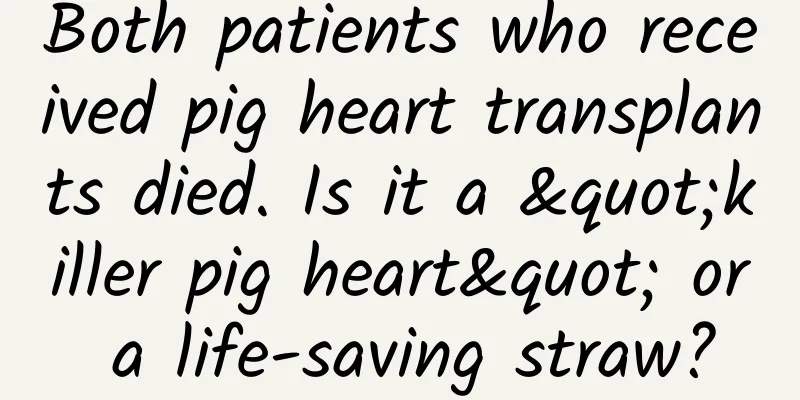Both patients who received pig heart transplants died. Is it a "killer pig heart" or a life-saving straw?

|
Another attempt by mankind to explore xenotransplantation came to an end recently. The University of Maryland Medical Center recently issued a statement: Lawrence Fawcett, a 58-year-old Maryland resident, who was the second human patient in the world to receive a pig heart transplant, died 40 days after receiving the pig heart transplant. Previously, the world's first transgenic pig heart transplant recipient, a 57-year-old male patient, David Bene, only survived for two months after the operation. Photos of the world's second pig heart transplant patient Why choose pig heart? Today, we need to face the fact that organ transplants are far from being in short supply. According to statistics from the World Health Organization (WHO), approximately 2 million people worldwide need organ transplants each year. Taking China and the United States as an example, there are currently about 300,000 registered people in need of organ transplants in China, but only about 16,000 organs can be successfully transplanted each year. In the United States, the organ transplant rate is about 20:1, and an average of 10 people die every day because they cannot wait for a suitable transplant organ. The severe shortage of donors is the biggest problem hindering these patients. Xenotransplantation is undoubtedly a promising solution to this problem. So why not use pig hearts instead of primates like gorillas, which are more similar to us? Gorillas It is understood that human experiments on xenobiotic organ transplantation can be traced back to the 17th century. Early human research focused on obtaining organs from primates. As early as 1984, a surgeon in the United States tried to transplant a baboon heart into a baby girl, but the baby only survived for 20 days before being declared dead. Nowadays, when scientists perform organ transplants, they mostly choose pig hearts rather than primate hearts. There are actually many reasons for this. First of all, primates such as orangutans and baboons, which are "distant relatives" of humans, carry some viruses that are more easily transmitted to humans. Moreover, when primate organs are transplanted into humans, there is a high probability that the effect of 1+1>2 will be produced, and the viruses will be "upgraded" in the human body to become more lethal viruses. Secondly, pigs and humans are closer in terms of diet, metabolic level, body temperature and heart rate. At the same time, the pig heart is similar to the human heart in size, duct distribution and power output. Moreover, pigs have been selected for xenotransplantation for a long time. At present, pig heart valves and pig pancreatic cells have successfully entered the human body. Pig skin has also been used as a temporary transplant for burn patients. pig Another reason is that it takes too long to raise a generation of primates like orangutans, with an average of 10 years for each generation, and usually only one baby per litter, which makes the cost of raising and keeping alive high. Pigs are different, as they only have one litter per birth and can grow to maturity in one year, making them more suitable for targeted breeding and large-scale reproduction. Therefore, it is inevitable that pig organs will be used as xenotransplanted organs for human transplantation. The hidden dangers behind pig organ transplantation Although pig organs are highly compatible with the human body, the deaths of two pig heart transplant patients have caused people to worry about the feasibility of similar operations. In fact, after the death of the first pig heart transplant patient, the research team has been exploring the cause of failure. Through a preliminary autopsy of the patient's heart, the research team found that the results were inconsistent with typical xenotransplant rejection. The patient's surgeon said at a webinar of the American Society of Transplantation that porcine cytomegalovirus may have a devastating effect on heart transplantation and is also a potential cause of the patient's death. On June 22, 2022, NEJM published a detailed report of the case. First pig heart transplant patient case report The second pig heart transplant patient was similar to the first patient in that there was no initial evidence of rejection, but the patient subsequently began to show the first signs of rejection and died within a few days. The implementation of two pig heart transplants initially demonstrated that the pig heart transplant into humans is feasible, at least the heart function was maintained in the early stages. However, the fact that both transplant patients died proves that this surgery is related to both the technology itself and individual differences. The overall situation can be summarized into the following aspects: The first is compatibility. Although the hearts of humans and pigs are the most compatible compared to other creatures, there are still differences between humans and pigs. Therefore, after a pig heart is transplanted into a human body, its operation will inevitably be out of sync, just like parts of different standards are assembled together, which will easily wear out over time, causing many problems. The second is immune rejection. Although genetic modification can minimize the rejection of pig hearts by the human immune system, human heart matching will still lead to greater rejection, not to mention the huge gap between pigs and humans. Even with the use of immunosuppressants, the overly strong rejection will eventually make the drugs ineffective. Finally, there is the issue of infection. The use of immunosuppressants to reduce immune rejection will weaken the body's defense against foreign pathogens, thereby increasing the risk of infection. Therefore, it is necessary to strike a balance between the use of immunosuppressants and infection, which is also a huge challenge. From this, we can see that there is still a long way to go if pig-to-human heart transplant surgery is to be carried out in depth. In this process, both breakthroughs in basic research and improvements in clinical operation processes are needed to maximize the normal function of organs while extending the patient's survival. Only in this way can the current bottlenecks faced by heart transplantation be effectively alleviated and as many safe and high-quality heart donors as possible be provided. |
<<: A ring that "should not exist" appeared in the solar system
Recommend
Start event planning from scratch!
When it comes to event planning , let’s start wit...
Douyin Blue V certification service provider in Lanzhou, Gansu!
Lanzhou Jimifeng Network Co., Ltd. is one of the ...
The leader of their migration is actually an airplane?
Right now, an incredible feat is taking place in ...
The Essence of Gravitation
The concept of gravity Gravity is the interaction...
A-share quantitative investment course that novices can understand - Quantitative Godfather Ding Peng
A-share quantitative investment course that novic...
“Stories of Delisting” in the Mobile Internet Era
New Year's Day is approaching, and at the tur...
Can't tell the difference between DNA, genes and chromosomes? A picture will help you figure it out
With the booming development of life sciences, we...
3 methodologies for selling goods through live streaming!
Nowadays, the so-called sales promotion is actual...
Learn management from Huawei, gain insight into management and become an excellent leader
How to manage well and enhance the core competiti...
Can’t push the product? You should understand the 4 social motivations of user behavior
When people generally do a needs theory analysis,...
Mount Emei, the other side you don’t know
Mount Emei is one of the four famous Buddhist mou...
Weekly crooked review: Winter is really coming
[[155241]] On this day, we, unable to resist the ...
Nutritionist's special reminder! Zibo barbecue is delicious, but you need to follow these 8 points to eat it healthily!
As the weather warms up, the barbecue industry ha...
The starting price of the Borgward BX3 is expected to be less than 100,000 yuan. Don't worry about whether it comes from Foton or Germany.
Since Borgward entered the Chinese market in 2016...









